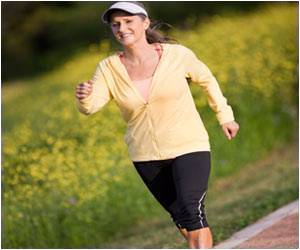Forget slow and steady wins the race, according to a recent study, alternating between walking and running, or wogging, is the best way to conserve energy.

‘When people have neither too much time nor too little time to reach their destination, they naturally switch back and forth between walking and running, which turns out to be the best strategy for saving energy.’





"We don't live our lives on a treadmill," said co-author Manoj Srinivasan. "To better understand how we move in our everyday life, and how our spontaneous movements relate to energy expenditure, we have to study what people do away from the treadmill. Once we have a good enough understanding of how we naturally move to conserve energy, we can build a solid theory and apply it in practical ways, designing better shoes, or better prosthetics that let people walk using less energy." In tests, 36 college students were asked to travel a distance a little longer than a football field, either on pavement outdoors or inside a school hallway. They were given a stopwatch, and told to arrive at their destination at a specific time, not before and not after, but right on time. The students were free to set their own pace to achieve that goal, and were not told whether to walk or run. Sometimes the students were told to make the trip in two minutes, so they could walk the entire way at a leisurely 2 miles per hour (about 1 meter per second) if they chose. At the other extreme, they were allotted only 30 seconds, so that they had to run the entire way at a brisk pace of 9 miles per hour (about 4 meters per second) to get there on time.
The researchers were most interested in what the students would do when they were allotted travel times between these two extremes. On a treadmill, people have to adjust their pace to match the machine in order to stay on the conveyer belt, but this study would reveal how people manage their gait, or movement pattern, when they can speed up and slow down whenever they want. The study revealed the existence of a "transition region" between 4.5-6.7 miles per hour (about 2-3 meters per second) when the students tended to make the trip through a mix of walking and running.
Regardless of any variable--fitness level, height, weight, leg length, the amount of time they were given for the trip, whether they were indoors or out--all the students employed a mixture of walking and running when they were moving at speeds within the transition region. Using data previously recorded by other researchers who measured the typical human energy costs for walking and running at various speeds, Long and Srinivasan calculated that dividing up the trip into spurts of walking and running saved energy. "Students seemed to naturally break into a run or slow down to a walk to save energy while ensuring that they arrived at their destination on time," Srinivasan observed.
The findings resonated with Leroy Long III, study co-author and doctoral student in STEM (Science, Technology, Engineering and Mathematics) education at Ohio State. As a recreational runner, he always feels less fatigued if he varies his gait at a natural pace. But other researchers have posed different hypotheses as to what physical factors cause people to vary their gait. "Previously, some researchers have argued that the speed at which we break into a run was really determined by other factors, such as muscle forces. However, such factors cannot explain why we sometimes use a mixture of walking and running.
Advertisement
Source-ANI







